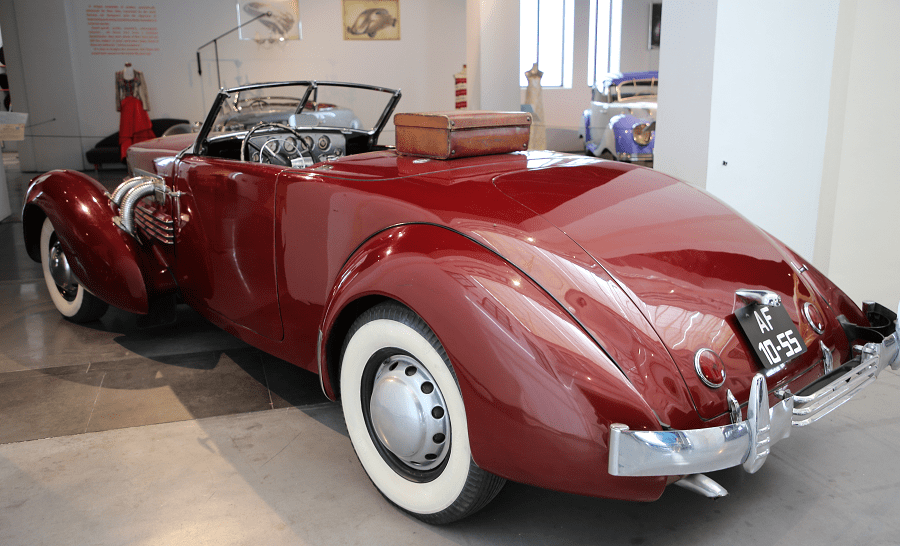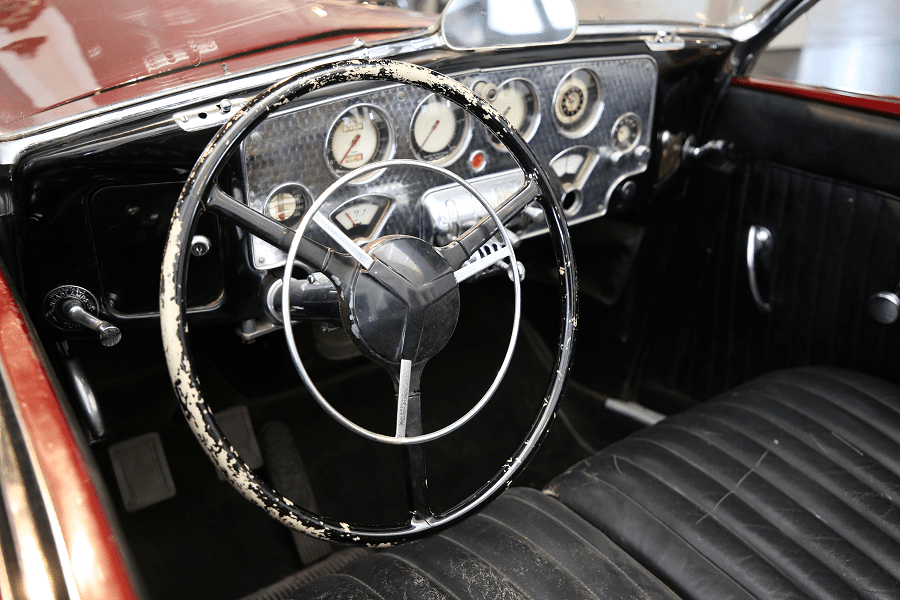Cord 812S (Supercharged)
The Cord 810, and later Cord 812, was a luxury automobile produced by the Cord Automobile division of the Auburn Automobile Company in 1936 and 1937. It was the first American-designed and built front wheel drive car with independent front suspension.
The styling of the Cord 810 was the work of designer Gordon M. Buehrig and his team of stylists, which included young Vince Gardner and Alex Tremulis. While the first American front-wheel-drive car with independent front suspension, it had an archaic tube rear axle with semi-elliptic rear springs. Power came from a 4,739 cc (289 cu in) Lycoming V8 of the same 125 HP (93 kW) as the L-29. The semi-automatic four-speed transmission (three plus overdrive) extended in front of the engine, like on a Traction Avant. This allowed Buehrig to eliminate the driveshaft and transmission tunnel. Accentuating its sleek, low-slung look, it also dispensed with running boards. It had a 125 in (3,175 mm) wheelbase (shared with several 812 body styles), and in 1936 came in four models: the entry-level sedan at US$1995, the Beverly sedan ($2095), Sportsman ($2145), and Phaeton ($2195). The 1937 812s had the same models, priced $2445, $2545, $2585, and $2645, plus two more, on a 132 in (3,400 mm) wheelbase, the $2960 Custom Beverly and $3060 Custom Berline called the Westchester.
Reportedly conceived as a Duesenberg and nearly devoid of chrome, the 810 had hidden door hinges and rear-hinged hood, rather than the side-opening type more usual at the time, both new items. It featured pontoon fenders with hidden headlamps (modified Stinson landing lights) that disappeared into the fenders via dashboard hand cranks. This car was the first and one of the few ever to include this feature.
It also featured a concealed lockable fuel filler door and variable-speed windshield wipers (at a time when wipers were often operated by intake vacuum, and so tended to stop when the driver stepped on the gas pedal). Its engine-turned dashboard included complete instrumentation, a tachometer, and standard radio (which did not become an industry standard offering until well into the 1950s). The most famous feature was the “coffin nose” that gave the vehicle its nickname; it featured a horizontally louvered wraparound grille, a product of Buehrig’s desire not to have a conventional vertical grille.
The car caused a sensation at its debut at the New York Auto Show in November 1935. The crowds were so dense attendees stood on the bumpers of nearby cars to get a look. Cord had rushed to build the 100 cars needed to qualify for the show, but the transmission was not ready. Even so, Cord took many orders there, promising Christmas delivery. Expected production of 1,000 cars per month failed however to materialize, as the semi-automatic transmission proved more troublesome than expected. The first production cars were not ready to deliver until February, and did not reach New York City until April 1936. In all, Cord managed to sell only 1,174 of the new 810 in its first model year, as the result of mechanical troubles.
Supercharging was made available with a mechanically driven Schwitzer-Cummins unit. Supercharged 1936 models were called 810S and 1937 models were called 812S. Supercharged models were distinguished from the normally aspirated models by the brilliant chrome-plated external exhaust pipes mounted on each side of the hood and grill. With supercharging, horsepower was raised to 170.
Aside from the small production of Cord 810/812, it was the last American front-wheel-drive cars for almost thirty years until the debut of the Oldsmobile Toronado in 1966, followed by a heavily redesigned Cadillac Eldorado in 1967. Both these GM divisional halo cars paid homage to 810/812 hidden headlamps. The second-generation Toronado introduced a hood design that resembled the 810/812 coffin nose and horizontal cooling grille.
Assembly: Auburn (Indiana, USA)
Years of production: 1936—1937
Length: 4966 mm
Width: 1803 mm
Height: 1524 mm
Engine: 8 cylinders; 4736 cm³
Power: 192 HP
Max speed: 165 km/h
Fuel consumption: 19 l/100 km
Weight: 1860 kg
See also Transport blog
See also Cars blog
See also Motorcycles blog
See also Buses blog
See also Shipbuilding blog
See also Motors and Engines blog
See also Trains and railways blog
See also Trucks and Cargo Vehicles blog
See also Tractors and Special Equipment blog
See also Tanks and Armored Vehicles
See also Airplanes blog
See also Helicopters blog
See also Artillery, Missiles and Rockets blog
See also Bicycles blog
















